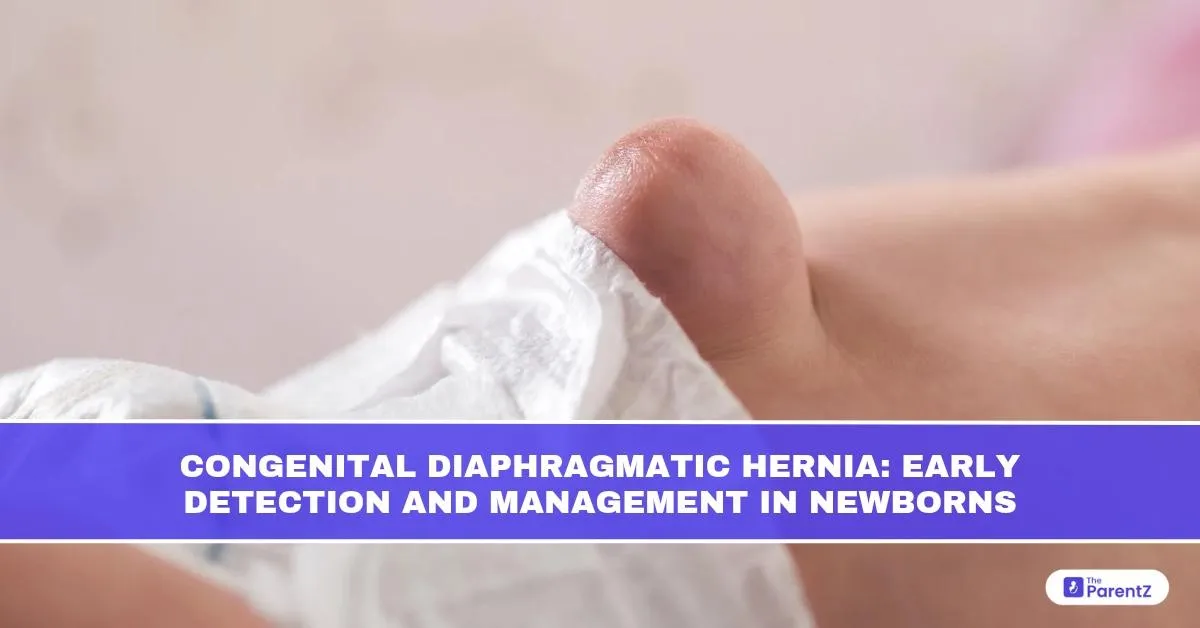The arrival of a newborn is a moment of joy, but sometimes, hidden structural issues within the body may complicate the earliest days of life. One such condition is Congenital Diaphragmatic Hernia (CDH), a potentially life-threatening birth defect that affects the diaphragm and lungs. Although rare, CDH demands immediate medical attention, as it impacts both breathing and overall organ development in newborns.
What is Congenital Diaphragmatic Hernia?
Congenital Diaphragmatic Hernia is a structural birth defect where there is an abnormal opening in the diaphragm, the muscle that separates the chest cavity from the abdomen. This hole allows abdominal organs such as the intestines, stomach, liver, or spleen to move into the chest cavity, crowding the developing lungs.
As a result, the lungs do not develop properly, a condition called pulmonary hypoplasia, leading to respiratory distress and complications immediately after birth.
Is CDH a Disease or a Disorder?
CDH is best classified as a congenital structural disorder, not a disease. It arises during fetal development due to improper formation of the diaphragm. While it can lead to serious medical issues, the underlying cause is anatomical and developmental, not infectious or degenerative.
Causes and Risk Factors
The exact cause of CDH is not always known, but it is believed to result from:
- Abnormal diaphragm development during 8–10 weeks of gestation
- Genetic mutations in a small percentage of cases
- Sometimes associated with chromosomal abnormalities (e.g., trisomy 18, trisomy 13)
- Environmental exposures during pregnancy (though less proven)
Most cases are sporadic, but in some families, a genetic predisposition may exist.
Types of CDH
There are three major types of CDH:
- Bochdalek Hernia: (most common, ~80–90%) Occurs on the posterolateral side of the diaphragm, usually on the left side. This allows organs like the stomach and intestines to enter the chest.
- Morgagni Hernia: Occurs on the anterior (front) part of the diaphragm, more often on the right. Less severe and often diagnosed later in life.
- Central Hernia: Very rare. Involves a central defect in the diaphragm.
Symptoms and Presentation in Newborns
In most cases, CDH is diagnosed before birth during routine pregnancy ultrasounds. However, if not diagnosed antenatally, the newborn may show symptoms within minutes to hours after birth.
Typical signs include:
- Severe difficulty breathing (respiratory distress)
- Cyanosis (bluish skin due to lack of oxygen)
- Scaphoid abdomen (sunken belly due to abdominal organs being in the chest)
- Asymmetrical chest expansion
- Diminished breath sounds on the affected side
- Displacement of the heart (shifted to the opposite side)
If not treated promptly, the baby may develop persistent pulmonary hypertension, a dangerous condition where the blood vessels in the lungs cannot carry enough oxygen.
How is CDH Diagnosed?
Prenatal Diagnosis:
- Ultrasound (18–22 weeks gestation): May reveal abdominal organs in the chest, absent stomach bubble in abdomen, or mediastinal shift.
- Fetal MRI or echocardiography: Helps assess lung size and cardiac involvement.
- Lung-to-head ratio (LHR) and observed/expected lung volume help predict the severity.
Postnatal Diagnosis:
- Chest X-ray immediately after birth: Shows bowel loops or stomach bubbles in chest cavity.
- Echocardiography: Evaluates heart position, function, and pulmonary pressure.
Prompt identification is critical to planning delivery and immediate neonatal care.
Immediate Management After Birth
A baby born with CDH requires urgent, skilled neonatal care. Delivery should occur in a tertiary care center with NICU and pediatric surgical support.
Initial steps:
- Avoid bag-mask ventilation, which can inflate abdominal organs and worsen lung compression.
- Use of endotracheal intubation and mechanical ventilation.
- Placement of a nasogastric (NG) tube to decompress the stomach.
- Stabilization before surgery: Oxygen support, blood pressure control, and management of pulmonary hypertension using medications like inhaled nitric oxide or sildenafil.
Surgical Repair
Once the baby is stabilized (usually within a few days), surgical repair is performed.
- The surgeon repositions abdominal organs into the abdomen and closes the diaphragmatic defect, sometimes using a synthetic patch if the hole is large.
- In cases of Morgagni hernia, surgery is often elective and less urgent.
- Minimally invasive techniques (thoracoscopic or laparoscopic) are used in selected stable cases.
Postoperative and Long-Term Care
Even after successful surgery, babies with CDH may require long-term monitoring and therapy, depending on the severity of lung and cardiac involvement.
Common post-op complications and needs:
- Prolonged oxygen support or ventilator dependence
- Gastroesophageal reflux (frequent in CDH survivors)
- Growth delays or feeding difficulties
- Neurodevelopmental delays due to hypoxia or NICU stays
- Recurrent hernia in some cases
Follow-up includes:
- Pediatric pulmonology for lung health
- Cardiology for pulmonary hypertension
- Nutrition and speech therapy
- Physiotherapy and developmental assessments
Prognosis: Can Babies with CDH Survive?
Survival rates have improved significantly, especially with prenatal diagnosis and early intervention.
- Overall survival for isolated CDH (no other anomalies): 70–80%
- Poorer outcomes if there are associated genetic or cardiac abnormalities, or severe pulmonary hypoplasia
Factors influencing prognosis include:
- Lung size (LHR, O/E lung volume)
- Degree of liver herniation into chest
- Presence of other anomalies
- Response to ventilation and oxygen
Emerging Therapies and Research
- Fetal Endoscopic Tracheal Occlusion (FETO): A promising in-utero procedure where a balloon is placed in the fetal trachea to promote lung growth. Used in severe cases under trial protocols.
- Advances in NICU care, gentle ventilation strategies, and targeted pulmonary hypertension therapies are improving outcomes.
- Genetic studies are ongoing to identify causes and recurrence risks.
Conclusion
Congenital Diaphragmatic Hernia is a complex but increasingly manageable condition with timely detection and skilled multidisciplinary care. Early diagnosis during pregnancy allows for optimized delivery planning, while advances in neonatal surgery and critical care offer hope for survival and long-term development.
For families, understanding CDH and seeking care at specialized centers can make a significant difference. While the path may be challenging, with the right support, many children with CDH go on to lead healthy, fulfilling lives.
References:
- Deprest J, et al. Fetal diagnosis and therapy of congenital diaphragmatic hernia. Nat Rev Dis Primers.
- Pediatric Surgery Journal – Management Guidelines for Congenital Diaphragmatic Hernia
- NHS Clinical Guidelines on CDH
- Indian Pediatrics – Congenital anomalies and fetal medicine
- American Academy of Pediatrics – Neonatal Pulmonary Disorders and CDH








Be the first one to comment on this story.